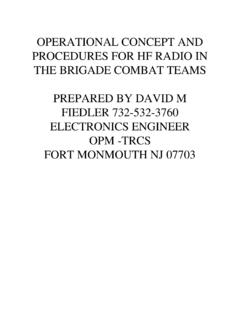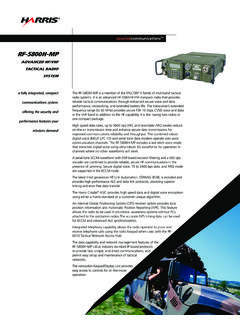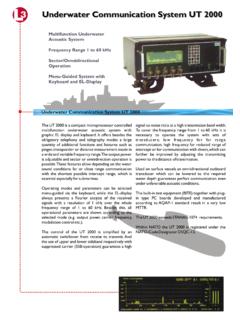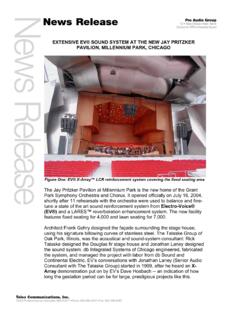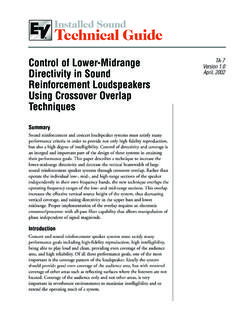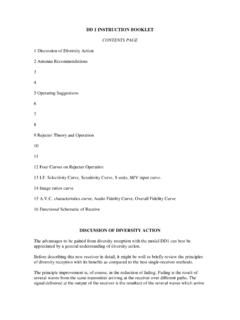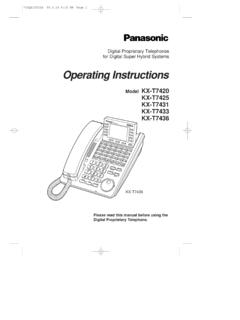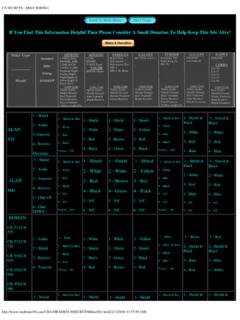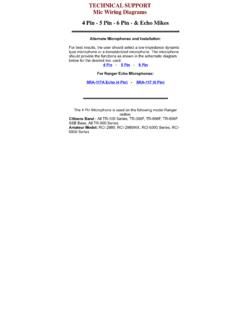Transcription of RCI-2950 DX TABLE OF RCI-2970 DX CONTENTS
1 - 1 - RCI-2950 DX RCI-2970 DX TABLE OF CONTENTS CHAPTER 1 PAGE SPECIFICATIONS General .. 2 Transmitter .. 2 Receiver .. 2 CHAPTER 2 INTRODUCTION Introduction .. 3 Features .. 3 CHAPTER 3 OPERATION Introduction .. 4 Control & Connections .. 4 Microphone .. 8 Operation .. 8 CHAPTER 4 PROGRAMMING Introduction .. 11 Frequency Selection .. 11 Frequency Scanning .. 11 Offset Frequency Operation .. 13 CHAPTER 5 CIRCUIT DESCRIPTION Introduction .. 14 PLL Circuit .. 14 Receiver Circuit .. 14 Transmitter Modulation Circuit .. 14 Transmitter Amplifier Circuit .. 14 CHAPTER 6 ALIGNMENT Required Test Equipment .. 18 Alignment Procedures .. 18 CHAPTER 7 MAINTENANCE Precautions .. 22 Periodic Inspection .. 22 Fuse Replacement .. 22 CHAPTER 8 DIAGRAMS AND PART LIST PCB Layout & Part List.
2 23 - 2 - RCI-2950 DX RCI-2970 DX CHAPTER 1 SPECIFICATIONS GENERAL Model RCI-2950 DX / RCI-2970 DX Frequency Range 12 meter : ~ MHz 10 meter : ~ MHz Tuning Steps 100 Hz, 1 KHz, 10 KHz, 100 KHz, 1 MHz Emission Modes AM(A3)/FM(F3)/LSB,USB(A3J)/CW(A1) Frequency Control Phase-Lock-Loop (PLL) synthesizer Frequency Tolerance % Frequency Stability % Operating Temperature Range 0 C to +40 C Microphone 400 ohm, Dynamic PTT Meter Function RF Output, RX Receive Signal Strength, SWR Calibration and SWR Input Voltage DC Antenna Connector UHF SO239 Dimensions For : RCI-2950 DX RCI-2970 DX 7-3/4 (W) x 10-3/4 (L) x 2-3/8 (H) 7-3/4 (W) x 10-3/4 (L) x 3-7/8 (H) Weight For : RCI-2950 DX RCI-2970 DX 4 lb. 3 oz. 7 lb. 6 oz. TRANSMITTER RF Power Output (RCI-2950DX) AM/FM/CW : 10 W ; SSB : 25 W PEP RF Power Output (RCI-2970DX) AM/FM/CW : 50 W ; SSB : 150 W PEP RF Transmit Modes AM/FM/SSB/CW Modulation A3E/16F3/J3E/A1A Spurious Emissions -50 dB Carrier Suppression -50 dB Antenna Impedance 50 Ohms RECEIVER Sensitivity For 10dB S/N (AM; CW/SSB) Sensitivity for 12dB S/N (FM) < V; < V < V Image Rejection Ratio -65 dB Automatic Gain Control (AGC) Figure Of Merit SSB/CW/AM : 80 dB for 50 mV for 10 dB Change in Audio Output Audio Output Power W @ 10% THD Built-in Speaker 8 Ohms, 5 Watts.
3 External Speaker (Not Supplied) 8 Ohms; 5 Watts. (SPECIFICATIONS SUBJECT TO CHANGE WITHOUT NOTICE) - 3 - RCI-2950 DX RCI-2970 DX CHAPTER 2 INTRODUCTION INTRODUCTION The Ranger RCI-2950 DX / RCI-2970 DX is a solid-state, fully synthesized Amateur 10 and 12 meter dual band mobile transceiver with full band coverage from MHz to MHz and MHz to MHz and all mode operation, including: AM, FM, USB, LSB, CW and PA modes. The 10 most commonly used frequencies can be pre-programmed by the user for easy channel access. RCI-2950 DX / RCI-2970 DX FEATURES 25 Watts PEP of Output Power ( RCI-2950 DX) 150 Watts PEP of Output Power ( RCI-2970 DX) Full Band Coverage All Mode Operation Brightness Control CTCSS Encoder/Decoder (Optional) Repeater/Offset Switch Programmable Frequencies Built-in Dual VFO RIT (RX Incremental Tuning) Squelch Noise Blanker RF Gain Control RF Power Output Selector External Speaker Connection PA Mode LCD Display Multi-Function LCD Meter - 4 - RCI-2950 DX RCI-2970 DX CHAPTER 3 OPERATION Figure 3-1 Front Panel INTRODUCTION This section explains the basic operating procedures for the RCI-2950 DX / RCI-2970 DX Amateur 10 and 12 meter dual band mobile transceiver.
4 CONTROL AND CONNECTIONS FRONT PANEL Refer to the above Figure 3-1 for the location of the following controls. 1. FREQUENCY SELECTOR This control is used to select a desired transmit and receive frequency. 2. RF POWER CONTROL This control allows the user to adjust RF power output. 3. MIC GAIN CONTROL Adjusts the microphone gain in the transmit and PA modes. This controls the gain to the extent that full talk power is available several inches away from the microphone. In the Public Address (PA) mode, the control functions as the volume control. - 5 -4. ON/OFF VOLUME CONTROL This knob controls the volume and the power to the radio. To turn the radio on, rotate knob clockwise. Turning the knob further will increase the volume of the receiver. 5. SQUELCH CONTROL This switch is used to eliminate background noise being heard through the receiver which can be disturbing when no transmissions are being received.
5 To use this feature, turn the switch fully counterclockwise and then turn clockwise slowly until the background noise is just eliminate. Further clockwise rotation will increase the threshold level, which a signal must overcome in order to be heard. Only strong signals will be heard at a maximum clockwise setting. 6. RF GAIN CONTROL This control is used to reduce the gain of the RF amplifier under strong signal conditions. 7. CLARIFIER CONTROL Allows tuning of the receive frequency above or below the assigned frequency by up to 500 Hz. Although this control is intended primarily to tune in SSB/CW signals, it may be used to optimize AM/FM signals. 8. MODE (FM/AM/USB/LSB/CW/PA) SWITCH This switch allows you to select one of the following operating modes: FM/AM/USB/LSB/CW/PA. 9. NB/ANL BUTTON (NB/ANL) In the NB/ANL position, the RF Noise Blanker and Aotumatic Noise Limiter in the audio circuits are also activated.
6 The Noise Blanker is very effective in eliminating repetitive impulse noise such as ignition interference. 10. ROGER BEEP BUTTON ( ) In the Roger Beep position, the radio transmits an audio tone at the end of your transmission to indicate that transmission has ended. As a courtesy to others, use the Roger Beep only when necessary. 11. SPLIT BUTTON (SPLIT) This control activates the offset frequency function. It causes the transmit frequency to be offset either above or below the receive frequency by a user programmable amount to allow operation of an FM Repeater. 12. PROGRAM BUTTON (PRG) This button is used to program operating or scanning frequencies into memory. See the OPERATION section of the manual for further details. 13. MANUAL BUTTON (MAN) This is used to return the unit to manual mode. 14.
7 SHIFT BUTTON (SHF) This is used to select 100 Hz, 1 KHz, 10 KHz, 100 KHz or 1 MHz frequency steps. 15. DIM BUTTON (DIM) This button adjusts the display backlighting in four different steps to best match the ambient light. - 6 -16. SWR BUTTON (SWR) This control is used to check SWR. 17. SCAN BUTTON (SCAN) This is used to scan frequencies in each band segment. The OPERATION segment of this manual provides detailed information on using the SCAN control. 18. MEMORY BUTTON (MEM) This button is used to program memory channels. Detailed information on how to use this control is provided in the OPERATION section of this manual. 19. ENTER BUTTON (ENT) This is used to program frequencies in memory. See the OPERATION section of this manual for more information on using this control. 20. LOCK BUTTON (LOCK) This button is used to lock a selected frequency.
8 Press it to activate the switch. In this position, it disables the Frequency Selector Control, up/down buttons on the front control panel and remote up/down buttons on the microphone. Repressing the switch will unlock the frequency. 21. UP/DOWN SELECTOR ( ) These buttons are used in conjunction with the shift key to move the frequency upward or downward to select a desired frequency. 22. METER This meter indicates received signal strength, transmitter RF output power and SWR level. 23. LCD DISPLAY The LCD displays the frequency selected, functions and memory channel. 24. MIC JACK Accepts 6 pin female connector with a type Philmore T616C or Calrad 30445 style connector. - 7 REAR PANEL Figure 3-2 represents the location of the following connections: Figure 3-2 Rear Panel 1. ANTENNA This jack accepts 50 ohms coaxial cable with a PL-259 type plug.
9 2. CW KEY This jack is for Morse code operation, To operate, connect a CW key to this jack and place the MODE switch in the CW position. 3. EXT. SP. This jack accepts 4 to 8 ohms, 5 watts external speaker. When the external speaker is connected to this jack, the built-in speaker will be disabled. 4. PA. SP. This jack is for PA operation. Before operating, you must first connect a PA speaker (8 ohms, 5 W) to this jack. 5. POWER This connector accepts DC power cable with built-in fuse. The power cord provided with the radio has a black and red wire. The black goes to negative and the red goes to positive. - 8 MICROPHONE 1. PTT SWITCH The receiver and transmitter are controlled by the push-to-talk switch on the microphone. Press the switch and the transmitter is activated, release switch to receive.
10 When transmitting, hold the microphone two inches from the mouth and speak clearly in a normal voice. 2. REMOTE UP/DOWN SWITCH An operating frequency can be incremented or decremented simply by pushing either of these buttons. OPERATION CHANNEL SELECTION Frequency selection for the RCI-2950 DX / RCI-2970 DX is simple. Select a desired operating frequency by rotating the Frequency Selector, or using the ( ) Up and ( ) Down buttons on the front panel or the microphone. Press the LOCK button to lock into the selected frequency. This will disable the Frequency Selector and the up/down buttons on the front panel and the microphone. Repressing the LOCK button unlocks the frequency. Use the SHF button to step frequency in either 100 Hz, 1 KHz, 10 KHz, 100 KHz or 1 MHz increment when you select a band segment. The frequency step is indicated by a small triangle directly under the corresponding digit on the frequency display.
